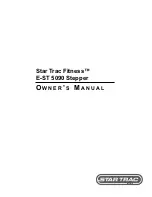
The Dialed In Menu System
B-22
Trap Door Test
When you enter the
Trap Door Test
, the LCD monitor will display the screen shown in figure B22.
The rectangle on the screen represents the current state of the trap door mechanism (on the far
left side of the playfield). When the trap door mechanism is in the open position, the rectangle
is light tan; when the trap door is in the closed position, the rectangle is dark tan; a red rectangle
represents a "broken" trap door mechanism (it failed to respond to several attempts to open it).
For reference, corresponding coil numbers and matrixed switch numbers are shown under each
square. Green text indicates the coil or switch is active; white text indicates that the coil or switch
is inactive.
You can use the
Enter
button to toggle the status (open or closed) of the trap door mechanism.
When you open the trap door, a new rectangle appears on top of the first one. This rectangle turns
blue when the switch underneath/inside the trap door mechanism is closed; when the switch is
open, the rectangle remains transparent.
Note: When the coin door is opened, the game’s safety interlock switch (the upper switch on item
4b, pg C-2 of this manual) disables the 70-volt power running to the playfield. To allow coils to
function in the
Trap Door Test
, you must either close the coin door or pull the safety interlock
switch’s actuator out (it will “click” and lock in place). When you close the coin door, the interlock
switch actuator will be pushed back into its normal (unlocked) position.
To exit the
Trap Door Test
at any time, press the
Back/Escape
button.
Figure B22. Trap Door Test screen.
Summary of Contents for Dialed in!
Page 2: ......
Page 4: ......
Page 15: ...Game Assembly Setup A 1 Game Assembly Setup Section A...
Page 43: ...The Dialed In Menu System B 1 The Dialed In Menu System Section B...
Page 99: ...Game Parts Information C 1 Game Parts Information Section C...
Page 104: ...Game Parts Information C 6 7 9 17 5 4 19 1 2 10 16 13 14 15 8 12 18 11 6 3 20 5 21 23 22...
Page 106: ...Game Parts Information C 8 1 2 3 4 5 6 7 8 9 10 11 12 13 18 15 16 14 17 19 20 22 21...
Page 114: ...Game Parts Information C 16 10 3 11 1 7 7 12 4 6 9 8 8 2 5 8a...
Page 126: ...Game Parts Information C 28 1 4 8 9 3 5 3 2 6 3 7...
Page 130: ...Game Parts Information C 32 7 2 4 8 1 11 3 10 5 6 12 15 9 13 14...
Page 148: ...Game Parts Information C 50 1 2 3 4 5 7 8 9 10 12 12 14 15 6 6 6 6 6 6 6 13 11...
Page 150: ...Game Parts Information C 52 1 2 3 4 5 6 7 8 9 10 12 10 10 10 10 11 11 13...
Page 160: ...Game Parts Information C 62 9 9 1 7 2 4 5 6 6 8 3...
Page 166: ...Game Parts Information C 68 1 2 3 4 5 6 9 10 11 12 13 14 17 19 21 22 26 27 28 35 36...
Page 168: ...Game Parts Information C 70 1 2 3 4 5 6 9 10 11 12 13 14 17 19 21 22 26 27 28 36 35...
Page 170: ...Game Parts Information C 72 41 42 44 45 46 47 48 57 58 59...
Page 172: ...Game Parts Information C 74 57 58 59 41 42 44 45 46 47 48...
Page 208: ...Game Parts Information C 110 1 2 2 2 3 4 5 6 11 9 10 10 10 7 8 12 12 12 13 15 14 16...
Page 210: ...Game Parts Information C 112 1 2 4 5 5 5 3...
Page 212: ...Game Parts Information C 114 1 2 5 6 7 8 4 9 11 10 12 13 14 15 17 17 18 19 20 21 16 24 23 22 3...
Page 222: ...Game Parts Information C 124 4 2 3 1 5...
Page 224: ...Game Parts Information C 126 1 2 3 1 2 3 4 4 5 5 5 5 5 5 5 5 5 5 5 6 6 9 8 10 7 11 13 12...
Page 236: ...Game Parts Information C 138...
Page 237: ...Reference Diagrams Schematics D 1 Reference Diagrams Schematics Section D...
Page 312: ...Reference Diagrams Schematics D 76...
Page 348: ...Reference Diagrams Schematics D 112 1 Fuse Locations In Bottom of Cabinet 4 2 3 In Backbox...
Page 354: ...Reference Diagrams Schematics D 118...
Page 355: ...Game Service Troubleshooting E 1 Game Service Troubleshooting Section E...
Page 367: ...Appendices...
















































